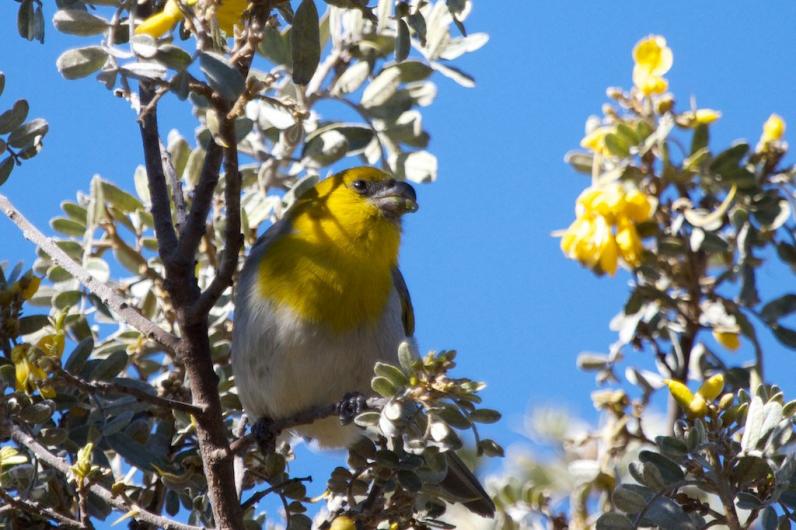New Mauna Kea birding trail reveals the palila, a rare endemic Hawaiian species

If you’re heading to Mauna Kea for some star gazing and have a few hours to kill before sunset, head to Hawaii Island’s newest public trail amid the mountain’s dry forest. There, at 7,000 feet and within dwindling strands of native mamane forest, is your only chance to spot the critically endangered palila, a chubby yellow bird that is the last living example of 16 species of finch-billed honeycreepers endemic to the Hawaiian Islands. Even if you’re not heading to star gaze on Mauna Kea, it’s worth the drive.
The Palila Forest Discovery Trail, a joint project between the Hawaii DLNR’s Mauna Kea Forest Restoration Project and the American Bird Conservancy, opened to the public late last month. The short one-mile groomed loop trail under tree canopies and through fields of knee-high grasses, is one of a series of birding trails that are expected to draw birders from around the world, when the Hawaii Island Coast to Coast birding corridor is unveiled at a stateside birding festival next month.
What makes this particular trail a standout is the unique ecosystem. Just five percent of the Island’s original mamane forest habitat remains, and the patch clinging to Mauna Kea is the largest remaining strand on the planet. Hawaiian honeycreepers, like Darwin’s specialized finches in the Galapagos, evolved from a common ancestor in a remote environment with specialized bills to feed on the Islands’ unique plants. Pods from mamane trees comprise some 90 percent of the palila’s diet, and is part of the reason this bird is found here and nowhere else.

I drove from Kailua-Kona, where it was a balmy 83 degrees to the chilly, 57-degree high elevation dry forest. The area receives an estimated 20 annual inches of rainfall, but I somehow managed to time my visit with a rare rainy afternoon. Fortunately, the four-mile four-wheel-drive-only path to the trailhead runs through the Kaohe Game Management Area wasn’t as challenging as I had anticipated (AWD vehicles should also be fine as long as there haven’t been heavy recent rains). At the trailhead in a mild downpour, I ran to the first of a series of unobtrusive signs along the path and scanned its QR code to learn more about the palila.
It wasn’t long before, through the pitter-patter of rain on the ground, I began to adjust and hear the birdcalls around me. Sweet trills coming from under covered branches. I spotted a few flashes of feathers but nothing definitive.
Pressing on, I came to a larger plaque describing the area’s destruction and its modern day restoration. The palila and its preferred plant foods were once found on Kauai and Oahu, but the Island’s changing land use eroded these habitats over time. On Mauna Kea, ranching that took place between 1857 and the 1930s decimated the forest. Couple that with a myriad of invasive species and a changing climate and you have the perfect (and unfortunate) recipe for mamane forest and palila extinction. Thankfully, some forward-looking Hawaii Island residents began to reverse the trend by reforesting Mauna Kea’s slopes in the 1930s—efforts that received a serious setback in the 1960s with sport hunter’s introduction of voracious mouflon sheep from Europe. At one lookout near the end of the trail, a clear fenced line obviously shows a 2006 forest restoration project—to the right mamane are sparse, still eaten by feral ungulates, and to the left, they are leafy and green.

The trail isn’t flat but it doesn’t have much elevation gain either. As I continued along, smartphone in hand to read the QR codes, I learned about other plants and animals uniquely evolved for the dry forest. No one knows exactly why Hawaiian stinging nettle here retain the ability to irritate skin, while other nettle plants throughout the Islands have lost the ability over time. The dry forest also has at least one species of “mint-less” mint—a plant in the mint family that has no aromatic resemblance to its mainland counterparts. In Hawaii, due to the lack of land-dwelling grazers, the mint no longer needed its telltale defense against them.
This land of strange plants and birds is not only rare, but sacred. Considered part of the wao akua (realm of the gods) the forest was revered by Native Hawaiians and rarely visited by humans other than the kahuna kalai pohaku (expert adze makers) and alii (chiefs) on pilgrimage to the mountains sacred sites. Queen Emma continued the tradition and was amazed by the areas natural beauty in 1881.
As I meandered through the damp landscape admiring rain droplets captured on spider webs, it was easy to appreciate that this is a unique and special place. At a curve in the trail, binoculars at the ready, I caught sight of a flurry of feathers. There, at about waist height and under the protection of a bushy mamane tree, were two of the trail’s namesake birds. Their distinctive yellow, grey and white bodies hopped between branches. One palila ruffled its feathers against the rain and plucked a giant seedpod from the tree, seemingly unaware that it was among the last of its kind.
To access the trail, take the fork where the Daniel K. Inouye Highway becomes the Saddle Road. Follow the fork for a little over a mile to the Kilohana Hunter Check-in Station. Two-wheel drive parking is available here, otherwise take your four-wheel drive vehicle four more miles along the hunting concession road to the Palila Forest Discovery trailhead parking. More detailed directions are found here. Note, due to several fence climbing ladders (to keep out large grazers) and some rough patches, this trail is not ADA accessible.


